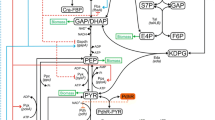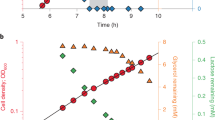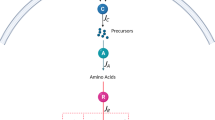Abstract
We analyzed the role of diffusion and cell size on the flux control properties of the glucose-PTS of Escherichia coli, in silicon cells under various metabolic conditions. To our surprise, the influence of the concentration of phosphoryl-donor PEP on the distribution of control was small. We found for cells of bacterial size that PTS-flux control was mainly located in processes taking place in the membrane and that diffusion hardly controlled the flux (< 2.8 %). Enlargement of the cells shifted the control from membrane to cytoplasm and from process rates to diffusion rates, the latter now having a total control of about 38 %. In the presence of glucose, nearly all diffusion flux control resided in the component that links the cytoplasmic processes to those in the membrane.
Similar content being viewed by others
References
Blom, J.G. and M.A. Peletier: 2000, ‘Diffusive gradients in the PTS system’. Report MAS-R0020 (CWI, Amsterdam), pp. 1–17
Elowitz, M.B., M.G. Surette, P.E. Wolf, J.B. Stock and S. Leibler: 1999, ‘Protein mobility in the cytoplasm of Escherichia coli’. J. Bacteriol. 181, 197–203
Heinrich, R. and T.A. Rapoport: 1974, ‘A linear steady state treatment of enzymatic chains. General properties, control and effector strength’. Eur. J. Biochem. 42, 89–95
Hogema, B.M, J.C. Arents, R. Bader, K. Eijkemans, H. Yoshida, H. Takahashi, H. Aiba and P.W. Postma: 1998, ‘Inducer exclusion in Escherichia coli by non-PTS substrates: the role of the PEP to pyruvate ratio in determining the phosphorylation state of enzyme IIAGlc’. Mol. Microbiol. 30, 487–498
Kacser, H. and J.A. Burns: 1973, ‘The control of flux’. Symp. Soc. Exp. Biol. 27, 65–104
Kholodenko, B.N., G.C. Brown and J.B. Hoek: 2000, ‘Diffusion control of protein phosphorylation in signal transduction pathways’. Biochem. J. 350, 901–907
Kholodenko, B.N. and H.V. Westerhoff: 1995, ‘Control theory of group transfer pathways’. Biochim. Biophys. Acta 1229, 256–274
Postma, P. W., J.W. Lengeler and G.R. Jacobson: 1993, ‘Phosphoenolpyruvate:carbohydrate phosphotransferase system of bacteria’. Microbiol. Rev. 57, 543–594
Rohwer, J.M., N.D. Meadow, S. Roseman, H.V. Westerhoff and P.W. Postma: 2000, ‘Understanding glucose transport by the bacterial phosphoenolpyruvate:glycose phosphotransferase system on the basis of kinetic measurements in vitro’. J. Biol. Chem. 275, 34909–34921
van Dam, K., J. van der Vlag, B.N. Kholodenko and H.V. Westerhoff: 1993,‘ The sum of the control coefficients of all enzymes on the flux through a group-transfer pathway can be as high as two’. Eur. J. Biochem. 212, 791–799
Woldringh, C. L. and N. Nanninga: 1985, ‘Structure of nucleoid and cytoplasm in the intact cell’. in Molecular cytology of Escherichia coli, ed. Nanninga, N. (Academic Press, London, New York), pp. 161–197
Author information
Authors and Affiliations
Rights and permissions
About this article
Cite this article
Francke, C., Westerhoff, H.V., Blom, J.G. et al. Flux Control of the Bacterial Phosphoenolpyruvate:Glucose Phosphotransferase System and the Effect of Diffusion. Mol Biol Rep 29, 21–26 (2002). https://doi.org/10.1023/A:1020389915464
Issue Date:
DOI: https://doi.org/10.1023/A:1020389915464




